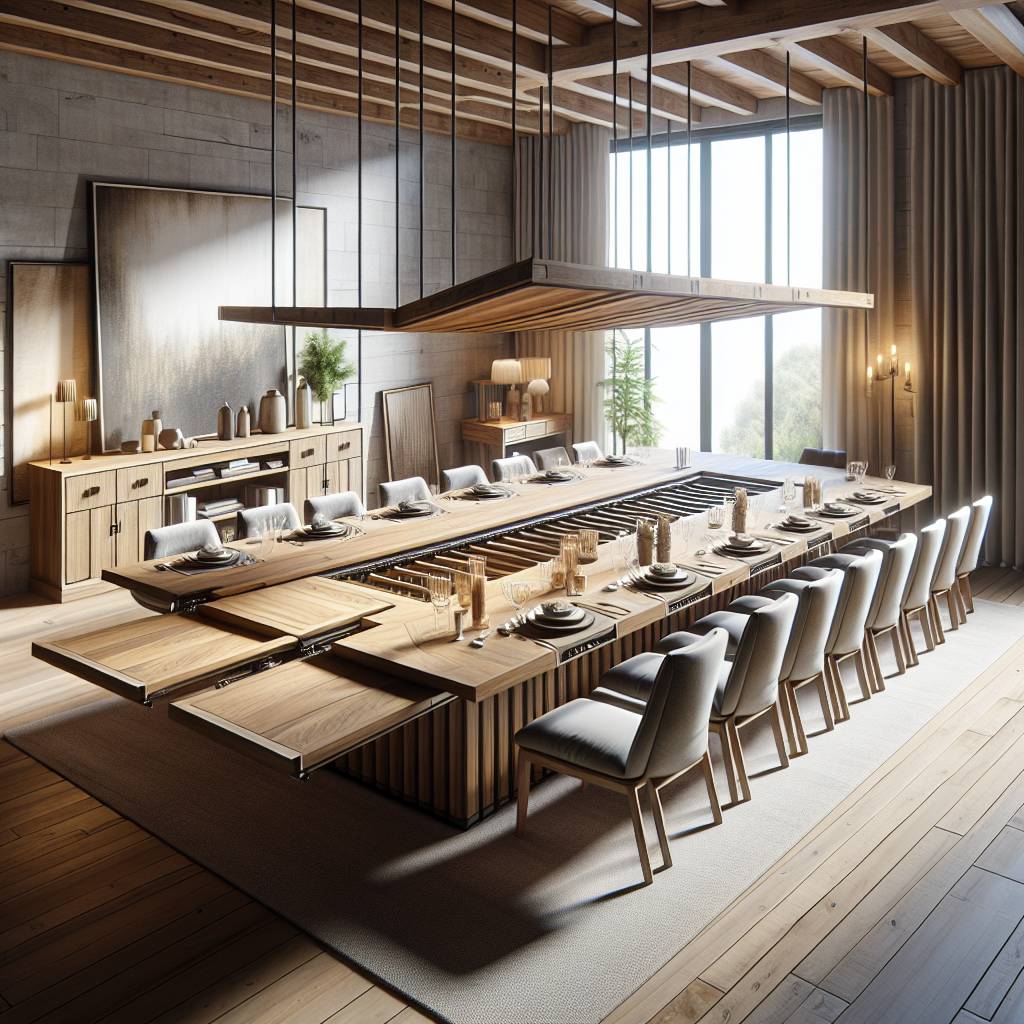Key Takeaways
- Embrace sustainable dining room design by choosing eco-friendly flooring, tables, and using low-VOC paints for a healthier space.
- Incorporate energy-efficient lighting, sustainable art, and maximize natural light to reduce energy consumption in your dining room.
- Opt for eco-friendly linens and upcycled decor ideas to minimize waste and promote a sustainable lifestyle.
- Support green dining by using local and seasonal food, reducing the carbon footprint associated with food transportation.
- Select natural materials and consider sustainable windows and awnings to create an environmentally friendly dining space.
- Take advantage of energy-efficient appliances to further reduce energy consumption and contribute to a more sustainable lifestyle.
Sustainable Dining Room Design Principles
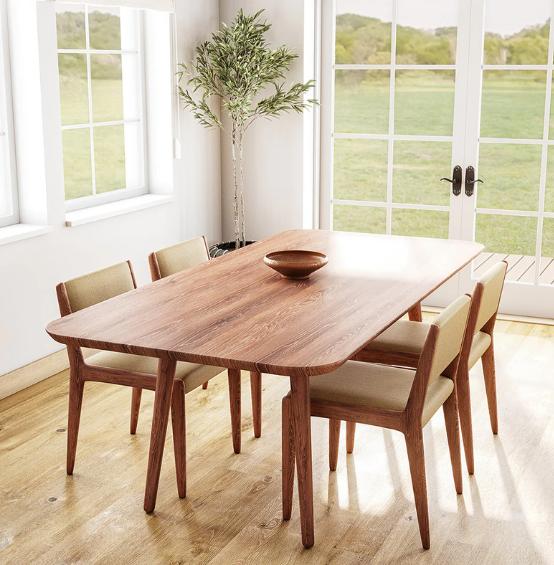
Natural and Recycled Materials
When decorating your dining room with an eco-friendly approach, consider incorporating natural and recycled materials. Look for furniture made from sustainable sources like reclaimed wood or bamboo. These materials not only add a touch of nature to your dining area, but they also help reduce the demand for new resources. For example, you can opt for a beautiful reclaimed wood dining table and design as the centerpiece of your eco-friendly dining room.
Another way to incorporate natural elements is by using items like jute rugs, cork placemats, or even wicker chairs. These choices not only bring warmth and texture to the space but also contribute to a more sustainable environment by using eco-friendly decor and waste dining room.
Non-Toxic Paint and Finishes
Choosing non-toxic and environmentally friendly paint and finishes, moldings, and plastics for your walls is crucial in creating an eco-friendly dining room. Look for paints that are labeled as low-VOC (volatile organic compounds) or VOC-free. These paints release fewer harmful chemicals into the air, contributing to better indoor air quality while minimizing harm to the environment.
In addition to paint, consider using finishes on furniture pieces for dining room design that are free from harmful chemicals. This includes varnishes, sealants, and stains used on wooden surfaces within your dining room design project.
Steps to Create a Sustainable Dining Space

Decluttering and Organizing
Start by decluttering your dining room design, removing any unnecessary items to create a clean and inviting space. Organize the remaining items efficiently, ensuring everything has its place. By doing so, you can minimize waste and make the most of the available space. For example, consider using storage solutions such as baskets or shelves made from sustainable materials like bamboo or rattan.
When organizing your dining room, think about how you can repurpose existing furniture or decor instead of buying new items. By upcycling old pieces or finding new uses for them, you reduce the need for additional resources and contribute to a more sustainable environment.
Maximizing Functionality
Consider the layout and flow of your dining room to maximize functionality while minimizing waste. Opt for multifunctional furniture that serves dual purposes, such as a table with built-in storage compartments or chairs that can be used in other areas of your home when not in use at the dining table.
Focus on natural lighting and ventilation to reduce energy consumption. Utilize window treatments that allow ample sunlight into the room during the day while maintaining privacy when needed. Incorporating indoor plants not only adds aesthetic appeal but also improves air quality within the space.
Eco-Friendly Cleaning Products
Maintain a healthy and sustainable dining environment by using eco-friendly cleaning products. Look for cleaning solutions that are free from harsh chemicals and toxins, opting for plant-based ingredients instead. These products are not only better for the environment but also promote a healthier living space for you and your family.
When selecting cleaning tools such as brushes, sponges, and cloths, choose options made from biodegradable materials like natural fibers or cellulose-based materials. This reduces reliance on synthetic materials that contribute to environmental pollution when disposed of.
Incorporating these steps into your approach to creating an eco-friendly dining room will help foster sustainability within your home while promoting an environmentally conscious lifestyle.
Choosing Eco-Friendly Flooring and Tables
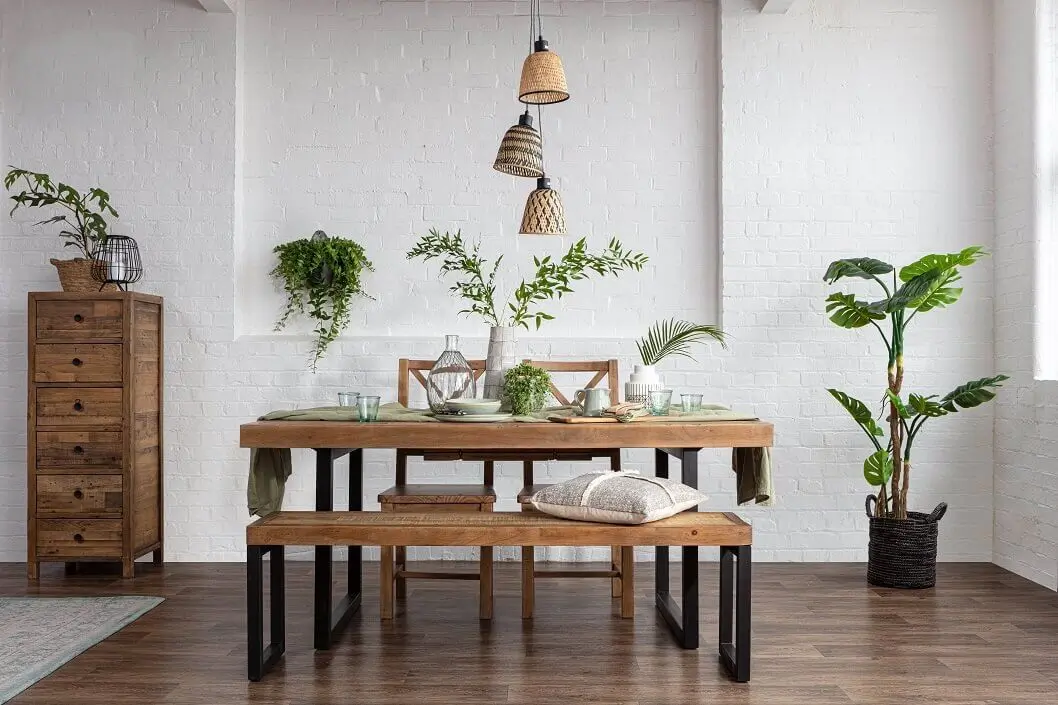
Renewable Flooring Options
One of the most important aspects is the flooring. Opt for materials like cork or bamboo. These options are not only sustainable but also biodegradable. By choosing renewable flooring, you can significantly reduce your environmental impact.
Consider the benefits of using cork as a flooring material in your dining room. Cork is harvested from the bark of cork oak trees without causing harm to them, making it a highly sustainable choice. It’s also a natural insulator and provides a soft, comfortable surface underfoot.
Reclaimed or FSC-Certified Wood Tables
Looking for ways to make your dining space more environmentally friendly? When selecting tables for your dining room, prioritize those made from reclaimed or FSC-certified wood. These options help minimize deforestation and reduce the demand for new timber.
By choosing furniture made from reclaimed wood, you’re giving new life to old materials that might otherwise end up in landfills. This approach not only reduces waste but also adds character and uniqueness to your dining area.
Natural Fiber Rugs
In addition to eco-friendly flooring and tables, consider incorporating rugs made from natural fibers like jute or sisal into your dining room decor. These rugs are durable, easy to maintain, and biodegradable at the end of their lifecycle.
Jute rugs are derived from the jute plant, which grows quickly with minimal water requirements and without pesticides or fertilizers in many regions around the world. Sisal rugs come from agave plants known for their hardiness in arid conditions—making them an excellent choice for sustainability-minded consumers.
Energy-Efficient Lighting and Sustainable Art
LED or CFL Bulbs
Installing LED or CFL bulbs is a great way to save energy. These types of bulbs not only reduce electricity costs but also have a longer lifespan compared to traditional incandescent ones. By using LED or CFL bulbs in your dining room fixtures, you can significantly lower your energy consumption while still enjoying well-lit meals with family and friends.
Incorporating these energy-efficient lighting options into your dining room not only benefits the environment but also contributes to cost savings on your utility bills. Plus, with advancements in technology, LED and CFL bulbs now come in various color temperatures, allowing you to create the perfect ambiance for any occasion without sacrificing environmental responsibility.
Sustainable Art Pieces
Integrating sustainable art pieces made from recycled materials or created by local artists is another fantastic way to enhance the eco-friendliness of your dining room decor. From repurposed metal sculptures to reclaimed wood wall art, there are numerous options available that align with sustainable living principles. Not only do these art pieces add character and uniqueness to your space, but they also serve as thought-provoking conversation starters during gatherings.
By supporting local artists who prioritize sustainability in their work, you contribute directly to the community while adding meaningful touches to your dining area. Furthermore, choosing sustainable art helps reduce waste by giving new life to materials that would otherwise end up in landfills. It’s a win-win situation where you get inspiring artwork for your walls while promoting environmentally conscious practices.
Dimmer Switches and Natural Light
To create an ambient atmosphere in your eco-friendly dining room without relying solely on artificial lighting sources, consider incorporating dimmer switches and maximizing natural light whenever possible. Dimmer switches allow you to adjust the brightness according to different activities such as intimate dinners or lively gatherings. This flexibility not only saves energy but also adds versatility to how you illuminate the space based on specific needs at any given time.
Leveraging natural light through strategically positioned windows or skylights can further minimize reliance on electric lighting during daylight hours. Embracing natural light not only reduces energy consumption but also offers health benefits by providing a connection with nature indoors.
Eco-Friendly Linens and Upcycling Decor Ideas
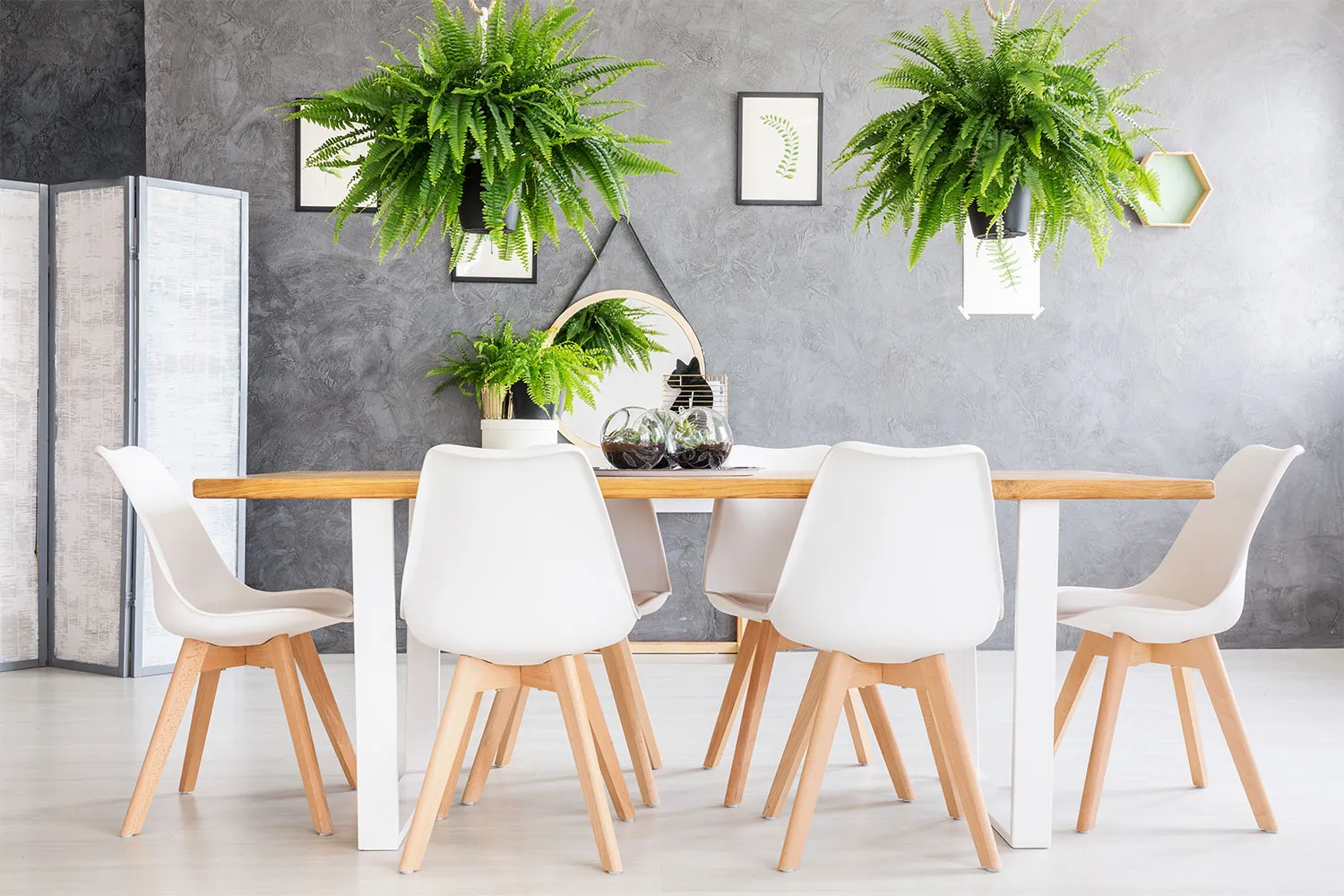
Organic Cotton and Linen Tablecloths
Opting for organic cotton or linen tablecloths and napkins is a great choice. These materials are free from harmful chemicals commonly used in conventional fabrics. By choosing these friendly decor options, you’re reducing the exposure of your family and guests to potentially harmful substances.
Organic cotton and linen are produced using sustainable farming practices that minimize environmental impact. This means that by selecting these textiles for your dining room, you’re contributing to a healthier planet. The use of eco-friendly linens also supports ethical labor practices in the textile industry.
Upcycling Decor Ideas
Embracing upcycling as part of your friendly decor approach can add character and charm to your dining space while reducing waste. For instance, repurposing glass jars as candle holders or vases not only gives them a new life but also prevents them from ending up in landfills.
Upcycling encourages creativity and resourcefulness in decorating your dining room without having to buy new items. It’s an opportunity to turn ordinary objects into unique pieces that reflect your personal style while promoting sustainability through reusing existing materials.
Sustainable Materials for Table Accessories
In addition to linens and upcycled items, incorporating sustainable materials like bamboo or cork into placemats, coasters, and other table accessories aligns with eco-friendly decor tips for the dining room. Bamboo is known for its rapid growth without the need for pesticides or fertilizers, making it an environmentally friendly choice.
Similarly, cork is harvested from the bark of oak trees without causing harm to the tree itself—allowing it to regenerate over time. Choosing these sustainable materials not only adds natural warmth and texture to your dining space but also reduces reliance on non-renewable resources typically used in traditional home decor items.
Local and Seasonal Food for Green Dining
Support Local Farmers
Supporting local farmers by sourcing fresh, seasonal ingredients is a great way to make your dining room more eco-friendly. By purchasing locally grown produce, you reduce the environmental impact associated with long-distance transportation. It supports the local economy and promotes sustainable farming practices.
When you buy from local farmers’ markets or directly from farms, you can often find a variety of fruits, vegetables, and other products that are in season. This not only ensures that your meals are made with the freshest ingredients possible but also reduces the need for preservatives and artificial additives commonly found in out-of-season produce.
Reduce Food Waste
Planning your meals according to what’s in season can help reduce food waste significantly. When foods are in season, they tend to be more abundant and less expensive. This abundance allows you to plan meals around specific ingredients without having to worry about them going bad before use.
Using leftovers creatively is an excellent way to minimize food waste. For example, leftover roasted vegetables can be repurposed into flavorful frittatas or used as toppings for homemade pizzas. Being mindful of how much food you actually need when cooking also plays a significant role in reducing waste.
Start a Small Herb Garden
Consider starting a small herb garden right in your dining room as part of your eco-friendly decorating efforts. Growing herbs such as basil, parsley, mint, or thyme indoors not only adds natural greenery but also provides fresh flavors at your fingertips while reducing reliance on store-bought packaged herbs.
Natural Materials and Low-VOC Paints for a Healthy Space
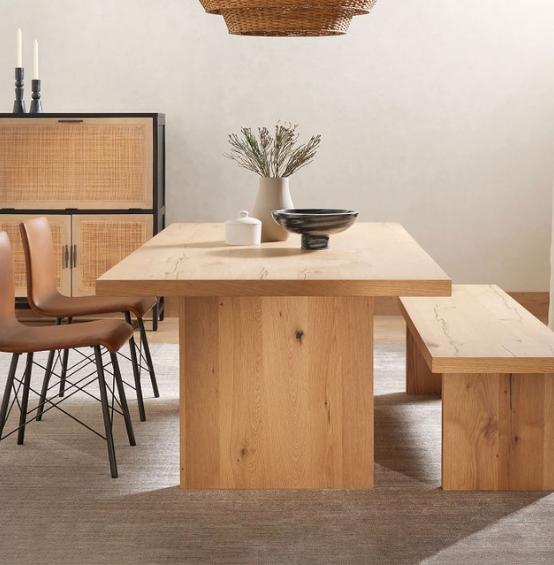
Sustainable Furniture Choices
When decorating an eco-friendly dining room, it’s essential to select furniture made from natural resources such as rattan or hemp. These materials are not only aesthetically pleasing but also sustainable and biodegradable. By choosing these options, you contribute to the preservation of the environment while creating a stylish dining space. For example, opting for a beautiful rattan dining table and chairs can add warmth and texture to your room while being environmentally conscious.
Minimizing Indoor Air Pollution
Incorporating low-VOC (volatile organic compounds) paints into your room design is crucial in creating a healthy indoor environment. Traditional paints often contain harmful chemicals that can linger in the air long after application, contributing to indoor air pollution. By selecting low-VOC paints, you minimize exposure to these harmful chemicals, ensuring that your dining room remains a safe and clean space for family meals and gatherings.
Embracing Greenery for Improved Air Quality
Integrating plants into your dining room decor not only adds natural beauty but also serves practical purposes by improving air quality. Plants act as natural air purifiers, removing toxins from the air while releasing oxygen, thus creating a calming ambiance within the space. Consider incorporating easy-to-maintain plants such as spider plants or peace lilies into your dining area to enjoy their aesthetic appeal while reaping their benefits for both health and decor.
Maximizing Natural Light and Energy-Efficient Appliances
Maximize Natural Light
Arranging your dining room furniture strategically can help maximize natural light. Placing mirrors opposite windows can reflect light, making the room brighter. Opt for sheer curtains or blinds made from sustainable materials to let in more natural light while maintaining privacy. By doing so, you reduce the need for artificial lighting during the day, which helps save energy.
Another way to maximize natural light is by choosing a lighter color palette for your dining room walls and furniture. Lighter colors reflect more light, making the space feel brighter and more open. This simple adjustment not only brightens up your dining area but also reduces the reliance on electricity for lighting.
Maximizing natural light doesn’t just benefit the environment; it also creates a warm and inviting atmosphere in your eco-friendly dining room.
Invest in Energy-Efficient Appliances
Investing in energy-efficient appliances is crucial. Look for appliances with an Energy Star rating as they are designed to consume less energy without sacrificing performance.
For instance, choosing an Energy Star dishwasher can lead to significant water and energy savings over time compared to traditional models. Similarly, opting for an Energy Star refrigerator ensures that you’re using less energy while keeping your food fresh.
By reducing energy consumption, these appliances contribute positively to both the environment and your household expenses. Not only do they help conserve resources like water and electricity, but they also operate quietly and efficiently—enhancing the overall experience of using them in your home.
Investing in these modern appliances aligns with creating a sustainable living space that prioritizes environmental responsibility without compromising convenience or functionality within your home.
Sustainable Windows and Awnings in Dining Room Design
Energy-Efficient Windows
Energy-efficient windows with double glazing can significantly improve the sustainability of your dining room. These windows are designed to reduce heat loss during colder months, keeping your dining area warm and comfortable without relying heavily on heating systems. By minimizing heat loss, you’ll also lower your energy consumption, contributing to a more eco-friendly household.
When choosing energy-efficient windows for your dining room, consider options with wood frames. Wood is a renewable resource that has minimal environmental impact compared to other window frame materials like aluminum or vinyl. Wood frames provide excellent insulation properties, further enhancing the overall energy efficiency of your dining space.
Eco-Friendly Window Treatments
In addition to installing energy-efficient windows, it’s essential to select sustainable window treatments for your dining room. Consider using awnings or shades to block direct sunlight during hot summer months. This simple addition not only reduces the need for excessive air conditioning but also prevents furniture and flooring from fading due to prolonged sun exposure.
You’re making a conscious effort towards sustainable living while enhancing the aesthetics of your dining area. These natural fabrics are biodegradable and have minimal impact on the environment compared to synthetic materials commonly used in conventional window treatments.
Frequently Asked Questions
How can I create a sustainable dining space?
To create a sustainable dining space, focus on using eco-friendly materials, energy-efficient lighting, and incorporating natural elements. Choose furniture made from reclaimed or sustainably sourced wood and opt for low-VOC paints to minimize indoor air pollution.
What are some eco-friendly flooring options for a dining room?
Consider bamboo, cork, or reclaimed wood flooring as they are sustainable options. These materials are renewable and have minimal impact on the environment compared to traditional hardwood or carpeting.
How can I incorporate local and seasonal food into my green dining routine?
Support local farmers by purchasing seasonal produce from nearby markets. This not only reduces the carbon footprint associated with transportation but also ensures fresher ingredients for your meals.
Why is maximizing natural light important in a sustainable dining room design?
Maximizing natural light reduces the reliance on artificial lighting, thus decreasing energy consumption. It also creates a warm and inviting ambiance while connecting inhabitants to the outdoors.
What are some examples of upcycling decor ideas for an eco-friendly dining room?
Upcycling decor ideas include repurposing old furniture, using mason jars as candle holders or vases, and creating art pieces from salvaged materials. Upcycling minimizes waste while adding unique character to your dining space.




